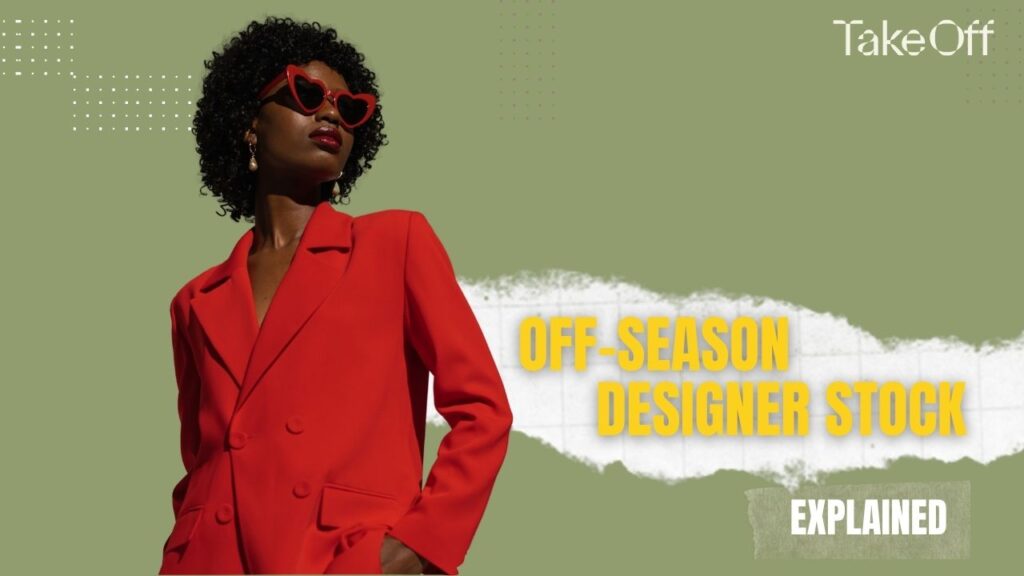Off-Season Designer Stock – Explained
25 June 2025

25 June 2025

Off-season designer stock isn’t just about leftover inventory or chasing discounts. It’s a strategic sourcing method that uses timing as leverage.
If you’re running a multi-brand retail business, fashion platform, or regional buying team, you know the challenge: aligning intake with your calendar, margins, and market climate. The smart solution? Strategic buying through off-season supply.
It’s not just a tactic for discount hunters. It’s a strategic move that lets you buy high-quality, brand-direct stock when everyone else is chasing seasonal hype. And in this market, predictability is more valuable than ever.
Let’s break it down: what off-season sourcing really is, how to use it strategically, and where to buy smarter – without overcommitting or getting caught in the trend chaos.
Let’s dive in!
In wholesale fashion, off-season isn’t a discount bin. It’s a supply cycle mismatch you can profit from.
Here’s what makes up most off-season inventory:
E.g. winter coats from European brands available during the Australian summer
Brands clearing out to make room for incoming ranges
Items bought for another market but unsold due to timing, not quality
Smart buyers use this supply mismatch to:
It’s not clearance stock. It’s time-shifted opportunity. In fact, many brands plan overproduction with B2B offloading in mind. They understand that excess supply can be a pipeline, not a liability, when redirected through smart wholesale partners.
Most B2B platforms structure inventory by trend tags or seasonal themes. That might work for Instagram. It doesn’t work for buyers with delivery deadlines.
Take Off instead structures collections around delivery windows.
That means:
This timing-first approach mirrors the off-price sourcing model used by leading wholesale buyers to reduce friction and increase forecast accuracy.
Example: A buyer in Dubai sourcing spring outerwear in December can align with EU oversupply – not guess what will be trendy in March.
Bottom line: When your intake is synced with your market’s calendar (not the source country’s), your sell-through rate spikes.
It’s about building a predictable rhythm that lets your operations, marketing, and cash flow all align in advance.
Here’s how seasoned buyers build their intake strategy:
Bundlex is built for visual, low-volume stock selection. You can browse curated packs with full metadata, brand info, and shipping logic already set.
Perfect for:
There’s no fluff. Every pack is tagged by delivery window, product type, and size curve, which means you can plug it into your intake planning without any guesswork.
Bundlex is also ideal if you’re shifting away from trend-dependent inventory and toward a non‑trend tagged inventory approach built on delivery logic and category planning.
Larger orders are handled via custom proposals.
These include:
Use this route if you want sourcing matched to your fiscal quarters, store clusters, or international warehouses. This method works particularly well for franchises, e-commerce brands, and aggregators.
Events like Who’s Next Paris or CIFF Copenhagen are still powerful for trend scouting and supplier meetings. But for fast-moving B2B intake, they’re too slow. Use them to meet, not to buy.
They’re more for vision than volume. A great place to network, see future ranges, and understand brand positioning – but you’ll still need structured proposals for actual procurement.
Telegram, Discord, and LinkedIn communities now host B2B fashion seller threads. Use tags like #offseasonstock or #wholesalefashion to find posts – but vet every source rigorously.
Some of these sellers are brand reps offloading overstock directly. Others are middlemen. The key is asking for brand traceability and delivery logic – not just price.
Anyone can send a PDF. Few can deliver reliable B2B volume.
Here’s what to verify before placing any order:
Red flag: If all you get is a PDF with styled photos and no size breakdowns, walk away. That’s reseller fluff.
Take Off is brand-direct. You get verified inventory, structured metadata, and export-ready documentation.
That reduces sourcing risk, protects your margins, and keeps your resale operation compliant.
The best B2B buyers aren’t sourcing one-off. They’re building quarter-by-quarter procurement calendars.
Here’s how:
Result? Zero panic buying. Zero deadstock spikes. Full alignment between intake and cashflow.
This also enables better collaboration across teams – your merchandisers, warehouse ops, and marketing leads all know what’s coming and when.
Let’s talk backend.
Off-season sourcing only works when the operational side runs clean. That means:
Take Off handles all of this in-house.
Whether you’re importing to the UAE, Canada, Germany, or Chile, your shipment arrives documented, prepped, and ready to move.
You can also request phased shipments and delivery splits – ideal for omnichannel models or staggered retail launches.
Here’s the economics:
For buyers, that means:
The added bonus? You’re often buying when logistics lanes are clearer, which means fewer delays and fewer customs issues. That improves your net resale window.
Add Take Off’s in-house ops and metadata-ready proposals, and you’re not just buying stock – you’re building a more stable business model.
These benefits are aligned with emerging resale fashion trends that reward operational planning over stylistic prediction.
Is this stock old or clearance?
No. It’s brand-direct, often pre-clearance or regionally unsynced. It’s about timing, not leftovers.
What if I only want 100–200 pcs?
Use Bundlex. You can browse, select, and pay per pack with full metadata.
What if I need multiple drops across countries?
Use Take Off’s large-order proposals. They support phased shipping and multi-country splits.
How do I know it’ll fit my customer base?
Use the size curve data provided to match to your past POS performance.
Do I need a logistics partner separately?
Not with Take Off. Freight, customs, and documentation are managed for you.
Stock shouldn’t be a gamble. With off-season logic, you’re sourcing with precision, not prediction.